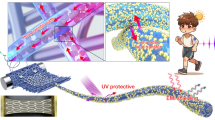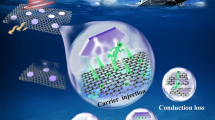Abstract
The Au film and glycerin selectively infilling photonic crystal fibers are analyzed by the finite element method. One cladding air hole is coated with Au film and infiltrated with glycerin to form a defect core. The simulation results show that both of the defect core modes formed on the glycerin and Au film can inspire resonance with core modes. The maximum sensitivity can reach to 2.50 nm/ ∘C in x polarized direction and 2.00 nm/ ∘C in y polarized direction for the temperature sensor, respectively. Furthermore, we obtain that the confinement losses of the photonic crystal fibers (PCFs) can meet with 321.442 dB/cm and 445.958 dB/cm at a short wavelength band (1460 ∼1530 nm) and an extended wavelengths band (1360 ∼1460 nm) for x polarized direction and y polarized direction respectively, which can be applied in many polarization filter devices as well. The compatibility of temperature sensor and polarization filter based on an identical structure can be realized at different wavelengths.









Similar content being viewed by others
References
Agranovich VM, Mills DL (2008) Surface polaritons-electromagnetic waves at surface and interfaces. Opt Express 16(25):20206–20214
Gao D et al (2014) Multi-hole fiber based surface plasmon resonance sensor operated at near-infrared wavelengths. Opt Commun 313:94–98
Zhang Y, Gu C, Schwartzberg AM, Zhang JZ (2005) Surface-enhanced Raman scattering sensor based on D-shaped fiber. Appl Phys Lett 87(12):123105–1-3
Lee H, Schmidt MA, Uebel P, Tyagi H, Joly NY, Scharrer M et al (2011) Optofluidic refractive-index sensor in step-index fiber with parallel hollow micro-channel. Opt Express 19(9):820–8207
Schmidt MA, Sempere LP, Tyagi HK, Poulton CG, Russell PSJ (2008) Waveguiding and plasmon resonances in two-dimensional photonic lattices of gold and silver nanowires. Phys Rev B 77(3):033417–1-4
Du Y, Li SG, Liu S, Zhu XP, Zhang XX (2012) Polarization splitting filter characteristics of Au-filled high-birefringence photonic crystal fiber. Appl Phys B 109(1):65–74
Sun B, Chen MY, Zhou J, Zhang YK (2013) Surface plasmon induced polarization splitting based on dual-core photonic crystal fiber with metal wire. Plasmonics 8(2):1253–1258
Qin W, Li SG, Yao YH, Xin XJ, Xue JR (2014) Analyte-filled core self-calibration microstructured optical fiber based plasmonic sensor for detecting high refractive index aqueous analyte. Opt Lasers Eng 58:1–8
Reddy PS et al (2012) Method for enhancing and controlling temperature sensitivity of fiber Bragg grating sensor based on two bimetallic strips. IEEE Photon F 4(3):1035–1041
Srivastava SK, Verma R, Gupta BD (2011) Surface plasmon resonance based fiber optic sensor for the detection of low water content in ethanol. Sens Actuators B Chem 153(1):194–198
Akowuah EK, Gorman T (2012) A highly sensitive photonic crystal fiber surface plasmon resonance sensor based on a bimetallic structure of gold and silver. IEEE 4th (ICAST):121–125
Gauvreau B et al (2007) Photonic bandgap fiber-based surface plasmon resonance sensors. Opt Express 15 (18):11413–11426
Qiu SJ, Chen Y, Xu F, Lu YQ (2012) Temperature sensor based on an isopropanol-sealed photonic crystal fiber in-line interferometer with enhanced refractive index sensitivity. Opt Lett 37(5):863–865
Lu Y, Wang MT, Hao CT, Zhao ZQ, Yao JQ (2014) Temperature sensing using photonic crystal fiber filled with silver nanowires and liquid. IEEE Photonics 6(3):1–7
Nagasaki A, Saitoh K, Koshiba M (2011) Polarization characteristics of photonic crystal fibers selectively filled with metal wires into cladding air holes. Opt Express 19:3799–3808
Lee HW, Schmidt MA, Tyagi HK, Sempere LP, Russell PSJ (2008) Polarization-dependent coupling to plasmon modes on submicron gold wire in photonic crystal fiber. Appl Phys Lett 93:111102–1-3
Fleming JW (1984) Dispersion in GeO 2-SiO 2 glasses. Appl Opt 23:4486–4493
Zhang W, Li SG, An GW, Fan ZK (2013) Polarization filter characteristics of photonic crystal fibers with square-lattice and selectively filled metal wires. Appl Opt 53(11):2441–2445
Zhang H, Wan BH (1998) Measuring the change of the index of refraction of liquid varying with temperatures. Physical Experiment of college II(1):1–3
Chen HL et al (2014) High sensitivity of temperature sensor based on ultracompact photonics crystal fiber. IEEE Photonics 6(6 ):1–6
Shuai BB et al (2012) Coexistence of positive and negative refractive index sensitivity in the liquid-core photonic crystal fiber based plasmonic sensor. Opt Express 20(23):25858–25866
Qin W, Li SG et al (2013) Numerical analysis of a photonic crystal fiber based on two polarized modes for biosensing applications. Chin Phys B 22(7):074213–1-6
Chen W, Thoreson MD, Ishii S (2010) Ultra-thin ultra-smooth and low-loss silver films on a germanium wetting layer. Opt Express 18(5):5124–5134
Acknowledgments
Project supported by the National Natural Science Foundation of China (Grant No. 61178026, 61475134, and 61505175).
Author information
Authors and Affiliations
Corresponding author
Rights and permissions
About this article
Cite this article
Wang, X., Li, S., Chen, H. et al. Compatibility of Temperature Sensor and Polarization Filter Based on Au Film and Glycerin Selectively Infilling Photonic Crystal Fibers. Plasmonics 11, 1265–1271 (2016). https://doi.org/10.1007/s11468-015-0170-5
Received:
Accepted:
Published:
Issue Date:
DOI: https://doi.org/10.1007/s11468-015-0170-5




